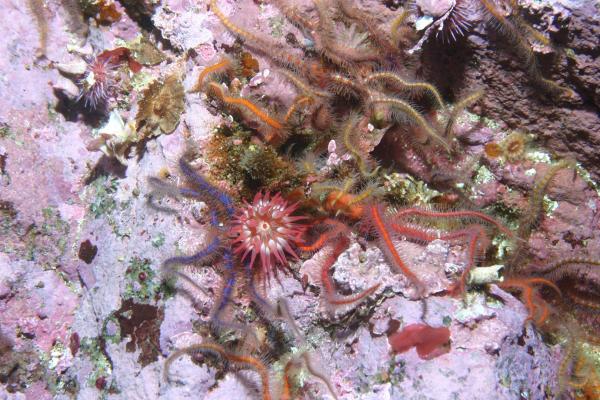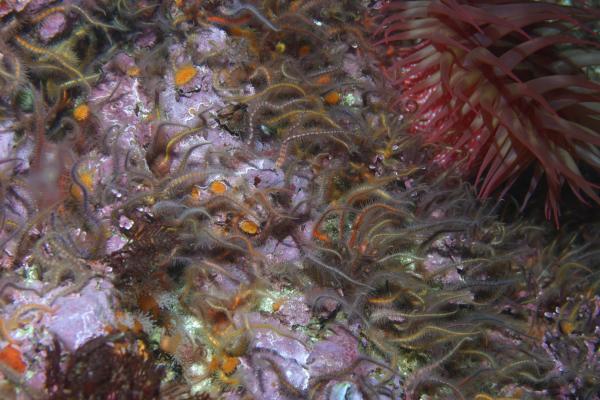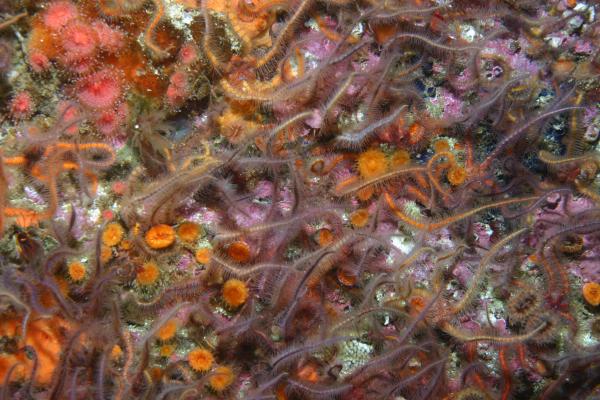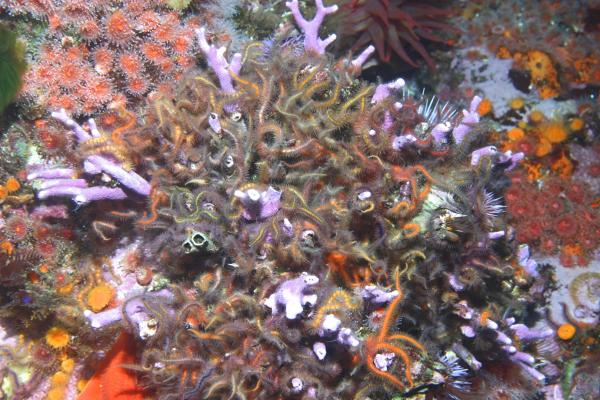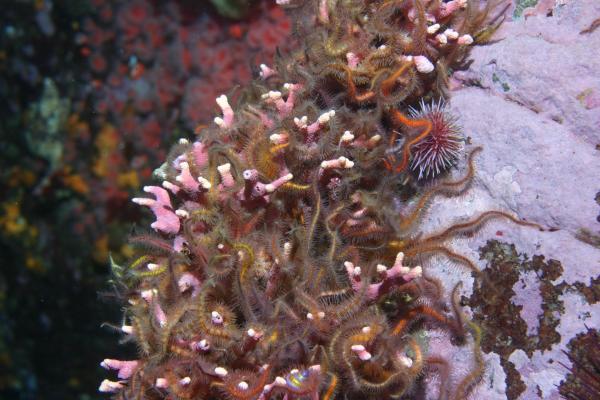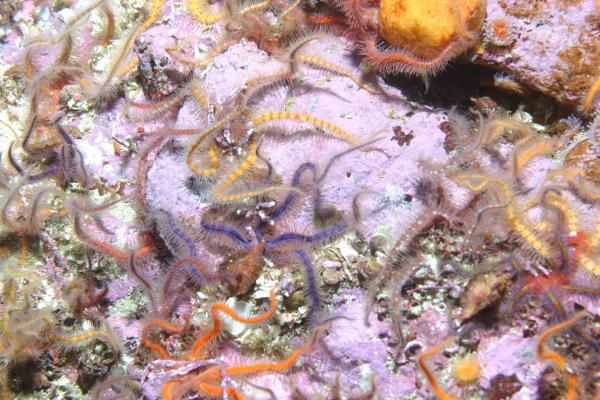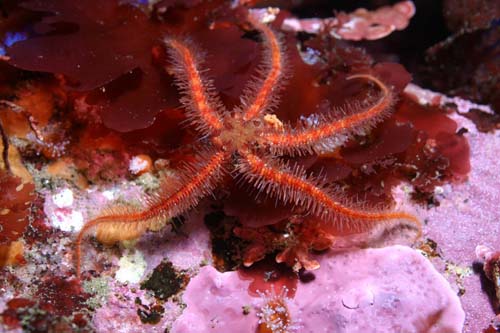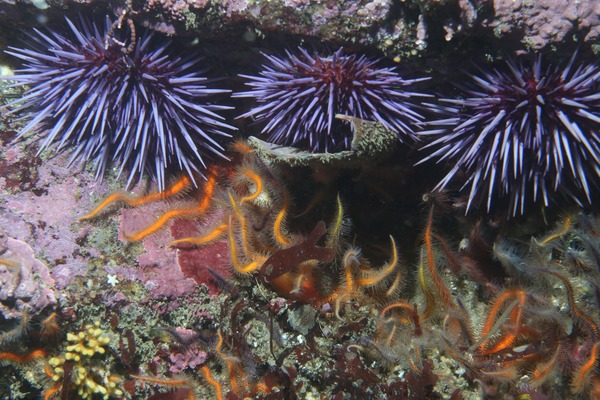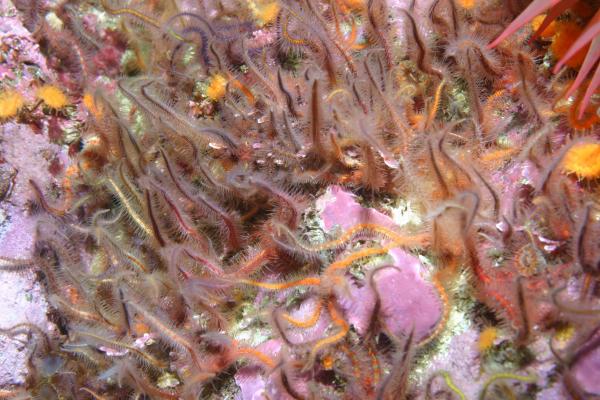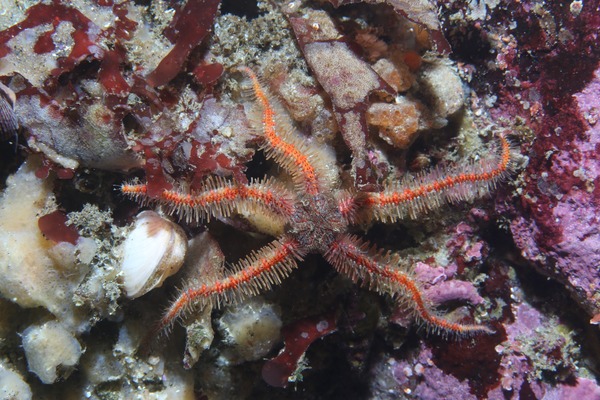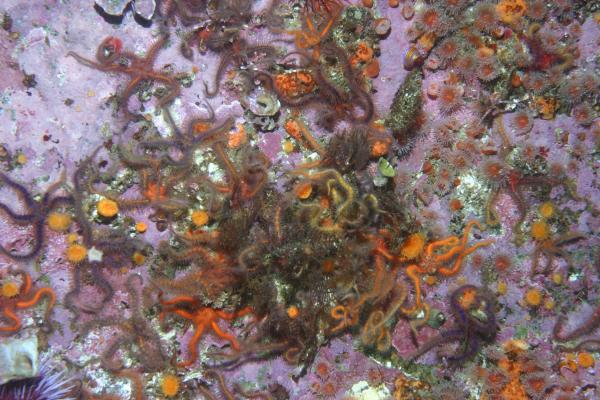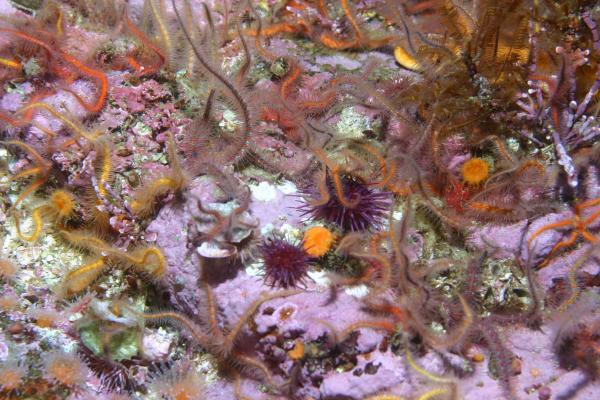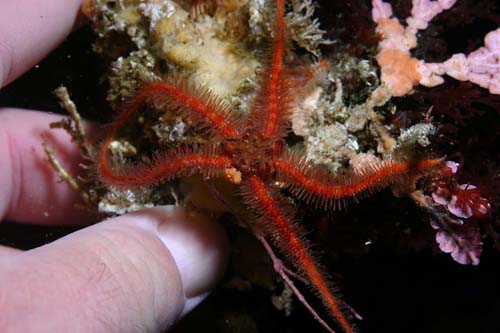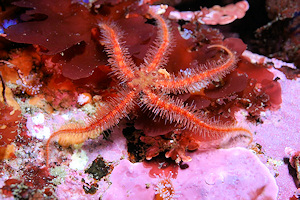
Spiny brittle star
Ophiothrix spiculata
Overview
Key Features:
Distinguised by serrate or conspicuously prickly spines on the disk and arms. Arm spines have jagged edges, radial symmetry with 5 segments.Primary Common Name:
Spiny brittle starSynonymous name(s):
Ophiothrix dumosaGeneral Grouping:
Sea stars, urchins, cucumbers, sand dollars, brittle starsGeographic Range:
Central California to Peru
Moss Beach (San Mateo CA) to Peru. Often seen under rocks, in rock crevices, and in algal holdfasts, low intertidal zone; subtidal on hard substrata to depths of 2,000 m. Common around and on all reefs where there is any potential hiding place or temporary protection.Intertidal Height:
0 to 0 feet (0 to 0 meters)Subtidal Depth Range:
Minimum Depth: 0 meters or 0 feetMaximum Depth: 2000 meters or 6250 feet
Habitats:
continental slope, kelp forest, submarine canyonNotes:
Under rocks, in rock crevices and mats of algae or invertebrates; from low intertidal to 2,000 m deep. Individuals typically insinuate one or more arms into fissures or crevices, anchoring with their straight and hooked arm spines. The remaining arms project into the water, where particles are caught by sticky secretions of spines and podia. The species occupies a wide range of substrates, and in current-swept habitats it can occur in extreme-ly large numbers.Abundance:
Relative Abundance:
O. spiculata occurs in large concentrations in favorable habitats. Common around and on all reefs where there is any potential hiding place or temporary protection. Population densities may be very high in certain areas. A siltstone reef in Orange County, bore up to 800 spiculata per 0.1 m². On the rocky bottom and kelp holdfasts at La Holla beach in San Diego, Limbaugh (1955) noted this species occurs in almost un-believable numbers in certain areas. The bottom of deeper water may be covered up to an inch or more by millions of these energetic animals. Specimens are not at all uncommon at the northern extremity of the range.Species Description:
General:
The spiny brittle star, Ophiothrix spiculata, has an average disk diameter of (15 mm), and an arm length of about 85 mm. They have long, thorny spines on the mar-gins of the arms and disk, and are found in orange, yellow, tan, brown, and green with various patterns. Brittle stars show beautiful color patterns of metabolically altered caro-tenoid pigments derived from ingested phytoplankton. The variegated patterns seem ela-borately fragmented, enough, perhaps, to confuse visual predators. Prominent thorny spines and longer, pale tube feet protrude from the sides of brittle stars arms. The tube feet are pointed and covered with tiny papillae, and they contain sense organs and mucus-secreting glands. Though lacking in suction cups, they help the animal adhere weakly to the substratum as well as aiding in feeding and respiration. The brittle stars mouth and sieve plate are on the underside. Its saccular gut lacks an anus and, together with the go-nads, fits inside the central disc.Distinctive Features:
Both disk and arms bearing prominent erect spines adorned with rows of hair-like spine-lets, the ventral arm spines near the arm tips in the form of toothed hooks: each jaw with a cluster of spines (toothed papillae) at the apex, but lacking oral papillae on sides. Brittle stars are so called because their arms readily break off or detach when seized. The animals regenerate these missing parts, while the predator is left with a writhing limb that is mostly skeletal blocks and spines of calcium carbonate. Ophiuroids can coil their arms around objects, holding even after death.Size:
Disc diameter: up to 18 mm, average ~15 mm. Arm length: 5 to 8 times the disk diameter, average ~85 mm.Natural History:
General:
There are approximately 2,000 known species of brittle star, which is more than any other group of sea stars. Brittle stars are strongly related to sea stars. They are characterized by radial symmetry from a central body where five snakelike arms project. The arms are very bendable. Compared to sea stars, brittle stars have a smaller central disc and no anus. Brittle stars are agile, using their entire arms to crawl over the substratum. Most brittle stars are nocturnal, therefore avoiding visual diurnal predators such as fishes. During the day Ophiothrix can be seen with only its arms occasionally extending from the animals hiding places beneath rocks, in the sand, and in kelp holdfasts. Brittle stars are among the most mobile echinoderms. Like sea stars, they do not depend on tube feet, which are sensory tentacles without suction. Brittle stars move moderately quickly, by wriggling their rays which are very bendable and enable the animals to make either rowing or snake-like movements. In ophiuroids the vertebrates are linked by well-structured longitudinal muscles, allowing them to travel horizontally. Ophiuroida moves quickly when distressed. One arm points forward, while the other four act as two pairs of levers, thrusting the body in a series of rapid jerks. Adults do not use their tube feet for locomotion, but very young stages use them as stilts, and they even serve as an adhesive structure. The attribution "brittle" refers to the ability of ophiuroids to voluntarily cast off (auto-tomize) their arms when adversely stimulated. During autotomy, which is under nervous control, the mutable connective tissue linking the arm joints abruptly deteriorates, and the arm immediately disconnects at the weakened junctures. Pieces of the arm that separate from the disk can remain active for many hours. The stump of arm remaining attached to the disk forms a new growing tip and may eventually regenerate to its original length. Spiny brittle stars serve as a major food item for reef fishes, particularly pile perch and they may also compete with smaller fishes and invertebrates for food. Brittle stars gener-ally sexually mature in 2 years, become full grown in 3 to 4 years, and live up to 5 years.Predator(s):
The sea star Astrometis sertulifera, elicits an avoidance escape response, and fishes such as the rock wrasse Halichoeres semicinctus, the pile perch Rhacochilus vacca, and the sand bass Paralabrax nebulifer. When roused from a hiding spot their best form of defense is to crawl away.Prey:
Drifting particles of plankton and detritus in the water columnFeeding Behavior:
OmnivoreNotes:
The Spiny brittle star is a scavenger, deposit & suspension feeder. Kelp holdfasts and clumps of bryozoans and worm tubes are often writhing masses of Ophiothrix arms. Individuals anchor themselves with spines from one or more arms, while extending the others into the water column for filter feeding. During feeding, Ophiothrix extends two-thirds of each arm upward, trapping plank-ton and detritus with its tube feet and with mucus strands on its spines. The animal then march food particles along to their mouth with the coordinated skill of their agile tube feet. Papillae that cover the animals tube feet, contain mucus-secreting glands that help adhesion to substrate, as well as aiding in feeding and respiration. Particles are caught by sticky secretions of spines and podia. The podia are papillose, pointed, and remarkably prehensile, wrapping around spines to clean off adherent particles, coiling around small organisms to capture them, and acting in a coordinated fashion with other tube feet on the arm to transfer captured and mucus-entrapped food to the jaws. The jaws close several times on each food mass, compacting the material before it is swallowed. The gut lining lacks cilia, and indeed cilia play no important role in the capture and transfer of food.Seasonal Behavior
Reproduction:
Few details of reproduction are known. However, spawning has often been noted in July at Pacific Grove CA. The egg sacs of ovigerous specimens may be seen protruding from the disk between the arms. Both eggs and sperm are shed (broadcast spawning), and ferti-lized eggs develop into free swimming, plankton feeding larvae. A few juveniles, pre-sumably arising from settled larvae, have been recovered from fouling panels immersed for 1-month intervals in Monterey Bay from April to August. Possible use of synchronous spawning has been observed in the wild. The animals respire and release waste and gametes through slits at the base of each arm. The gonads, along with its saccular gut and anus, fit inside the central disk.Migration:
As they increase in age and body size, many ophiuroids, including California and Oregon intertidal species, migrate from one microhabitat to another. Most large ophiuroids live in bedrock, beneath boulders and cobbles. The smaller species and juve-niles, occur among fronds, holdfasts, and rhizomes of plants, and in protective clumps of bryozoans, hydroids, worm tubes, echinoid spines and so on.Issues
Monterey Bay National Marine Sanctuary:
Used oil from cars, which is poured down the drain, winds up in lakes, rivers, and the ocean. No matter where it comes from, oil harms animals in the ocean. Every year, Americans dispose of 220 million gallons of oil illegally, which is twenty times that of the Exxon Valdez spill. Everything that makes it's way into the ocean, whether it\'s littered, washes of the beach, or falls off boats, may ultimately make its way to the ocean. The deep sea is not so far, that it\'s beyond the reach of human activity. Creatures living in the deep are affected by what humans do on land. Tide-poolers, divers, and Beachcombers, must remember not to disturb or collect any creatures that they come across. Removal of animals from any ecosystem can disrupt the diversity, and ecological processes in areas that are frequently visited.References
- Carlton, J.T. 2007.
The Light and Smith Manual, 4th edition
Intertidal Invertebrates from Central California to Oregon
University of California Press. 1001 p.
- Langstroth, L. and L. Langstroth. 2000. A Living Bay: The Underwater World of Monterey Bay. University of California Press, Berkeley and Los Angeles, CA. 287 p.
- Meinkoth, N.A. 1998. National Audubon Society Field Guide to North American Seashore Creatures. A.A. Knopf, New York, NY. 813 p.
- Morris, R.H., D.P Abbott, and E.C. Haderlie. 1980. Intertidal Invertebrates of California. Stanford University Press, Stanford, California. 690 p.
- Ricketts, E. F., J. Calvin, and J.W. Hedgpeth. 1985. Between Pacific tides. Stanford University Press, Stanford, CA. 652 p.
- WWW
Monterey Bay Aquarium. Online Field Guide, 2008.
http://www.mbayaq.org/efc/living_species/
Accessed [04/27/06]
Accessed 01/30/2009 for Pelagic Cormorant
Accessed 8/19/09 for Bryozoan
Accessed 7/31/09 for Spiny brittle star
Accessed 3/31/09 for Sunflower star
Accessed 8/9/09 for red octopus
Accessed 8/19/09 for Decorator crab
Accessed 7/31/09 for warty sea cucumber
Related Information
Photo Library
Click on an image below to view a larger version in the SIMoN Photo Library. You will also be able to view important information on each photo such as photographer, date, caption and more
